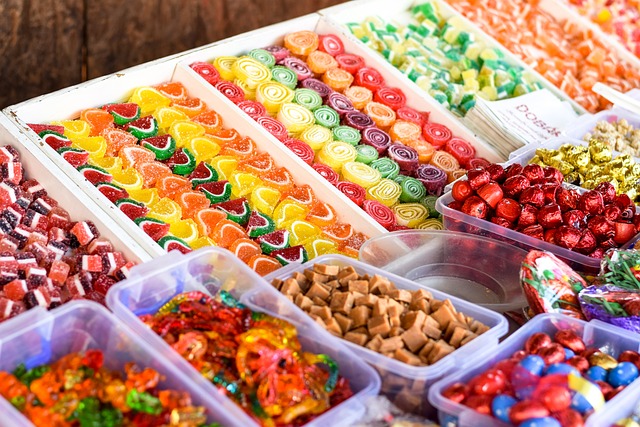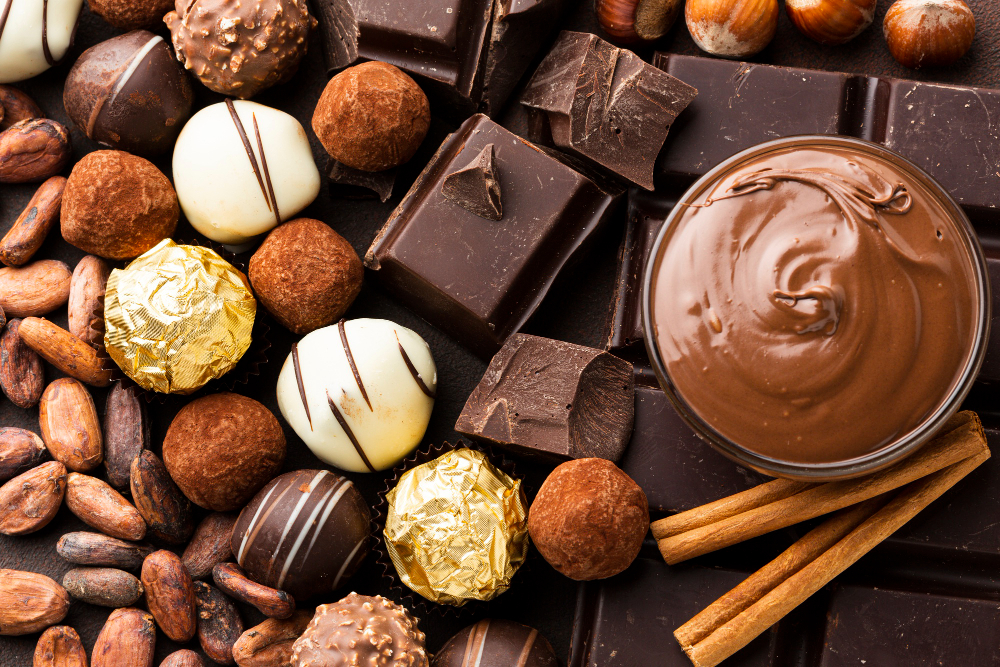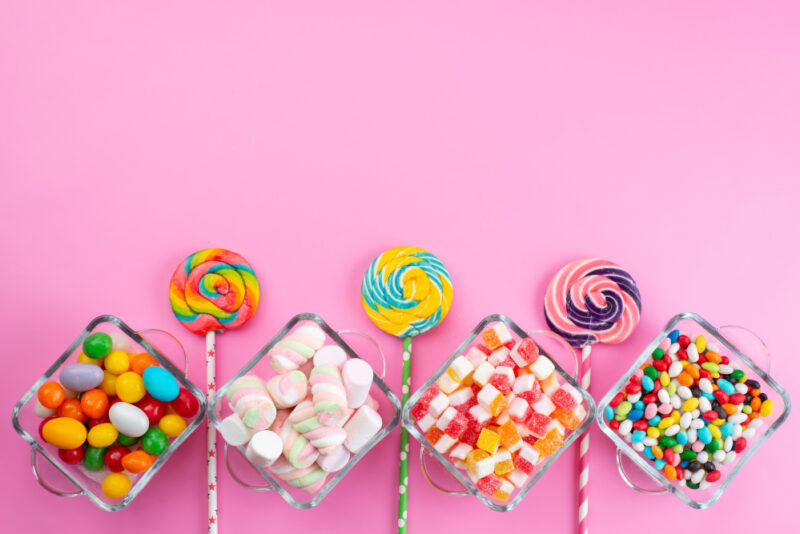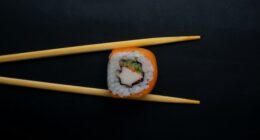Candy refers to a broad category of sugary confections that come in various forms such as hard candies, gummies, lollipops, and more. Chocolate is derived from cocoa beans and typically includes additional ingredients like sugar, milk powder and cocoa butter.
TL;DR Candy Vs. Chocolate
Candy refers to a wide range of sweet confections made from sugar or sweeteners, often with various flavors and textures.
Chocolate, on the other hand, specifically refers to confections made from cocoa solids and cocoa butter, with additional ingredients like sugar and milk in some varieties. While chocolate is a type of candy, not all candies are made from chocolate.
What is candy?

Candy is a broad term encompassing an array of treats made primarily from sugar or syrup. From nostalgic childhood favorites like gummy bears and lollipops to contemporary confections like sour candies and chewy fruit snacks, the world of candy knows no limits.
One distinguishing characteristic of candy is its versatility. It can be hard or soft, chewy or crunchy – there’s something for everyone’s preference! Whether you enjoy savoring a piece slowly or popping multiple candies at once for an explosion of flavors, the choice is yours.
What is chocolate?

Chocolate is a food product made from the beans of the cacao tree, scientifically known as Theobroma cacao. These beans are harvested, fermented, dried, roasted, and then ground to produce cocoa solids and cocoa butter.
Chocolate comes in many forms like bars, chips, and powders . It has a rich and complex flavor profile that ranges from sweet to bitter. The taste largely depends on factors like the type of cocoa bean used, processing techniques employed, and added ingredients such as sugar or milk.
Candy Vs. Chocolate – Key differences
| Characteristic | Candy | Chocolate |
|---|---|---|
| Main Ingredient | Made from a variety of sweeteners, such as sugar, corn syrup, and flavorings | Derived from cocoa beans |
| Texture | Can have various textures, such as hard, chewy, gummy, or soft | Typically smooth and creamy texture |
| Cocoa Content | Does not contain cocoa or contains minimal cocoa, if any | Contains cocoa solids and cocoa butter |
| Flavors | Offers a wide range of flavors, including fruit, mint, sour, and more | Primarily comes in milk, dark, or white chocolate |
| Variety | Comes in a diverse range of shapes, sizes, and types | Available as bars, truffles, and other confections |
| Melting Point | Melts at different temperatures, depending on ingredients | Melts around body temperature (approximately 93°F or 34°C) |
| Nutrition | Tends to be higher in sugar and may have artificial additives | Contains some antioxidants and healthy fats (in dark chocolate) |
| Common Types | Hard candies, gummies, lollipops, caramels, licorice, etc. | Milk chocolate, dark chocolate, white chocolate, etc. |
| Processing | Can be made without the need for cocoa processing | Requires cocoa bean fermentation and processing |
| Uses | Consumed as a standalone sweet treat or used for decorating and garnishing | Eaten as a sweet indulgence, used in baking, and made into desserts |
| Allergens | Can contain a wide variety of ingredients, so may pose allergen risks | Cocoa and milk (in some chocolates) are common allergens |
What Is Not Candy?
Not everything sweet or sugary is considered candy. Candy refers specifically to confections made from a combination of sugar or sweeteners, flavorings, and often other ingredients like corn syrup, chocolate, or fruits.
Candy is usually processed and comes in various forms, such as hard candies, gummies, caramels, chocolates, and more.
Things that are not candy include
- Fruits: Fresh fruits like apples, oranges, strawberries, and bananas are not candy, although they contain natural sugars.
- Baked Goods: Items like cakes, cookies, muffins, and pies are not considered candy, even though they may contain sugar.
- Ice Cream: Ice cream and frozen desserts, while sweet and often containing sugar, are not classified as candy.
- Beverages: Soft drinks, fruit juices, and other sweetened beverages are not considered candy.
- Honey and Maple Syrup: Although sweet, honey and maple syrup are natural sweeteners and not categorized as candy.
- Cereal: Breakfast cereals, even if they contain sugar, are not considered candy.
- Sweetened Snacks: Items like sweetened granola bars, yogurt, and sweet popcorn are not candy.
- Desserts: Traditional desserts like puddings, custards, and fruit salads are not classified as candy.
- Chewing Gum: While sweet and sugary, chewing gum is not considered candy.
- Sweet Sauces: Condiments like chocolate sauce, caramel sauce, and fruit syrups are not candy.
Types of chocolate
- Milk Chocolate
- Dark Chocolate
- White Chocolate
- Bittersweet Chocolate
- Semi-Sweet Chocolate
- Unsweetened Chocolate
- Couverture Chocolate
- Ruby Chocolate
- Gianduja Chocolate
- Compound Chocolate
Types of candy
- Hard Candies (e.g., lollipops, candy canes, jawbreakers)
- Gummies (e.g., gummy bears, gummy worms)
- Chocolates (e.g., chocolate bars, truffles)
- Caramels (e.g., caramel candies, caramel chews)
- Licorice (e.g., black licorice, red licorice)
- Taffy (e.g., saltwater taffy)
- Marshmallows (e.g., marshmallow candies, marshmallow treats)
- Sour Candies (e.g., sour gummies, sour belts)
- Jelly Beans
- Mints (e.g., peppermints, breath mints)
Which is better candy or chocolate?
Some people may prefer candy because it comes in a wide variety of flavors, textures, and forms, offering a diverse range of sweet treats. Candy can include gummies, hard candies, caramels, licorice, and more.
Chocolate is beloved by many for its rich, smooth, and creamy taste. It comes in different types, including milk chocolate, dark chocolate, and white chocolate.
Chocolate also contains antioxidants and may offer some health benefits when consumed in moderation, especially dark chocolate with higher cocoa content.
Ultimately, the “better” choice comes down to personal preference. Some people may have a sweet tooth and enjoy a wider variety of candies, while others may savor the deep and indulgent flavors of chocolate.
Image Credits
Featured Image By – KamranAydinov on Freepik
Image 1 By – Pexels from Pixabay
Image 2 By – Freepik








